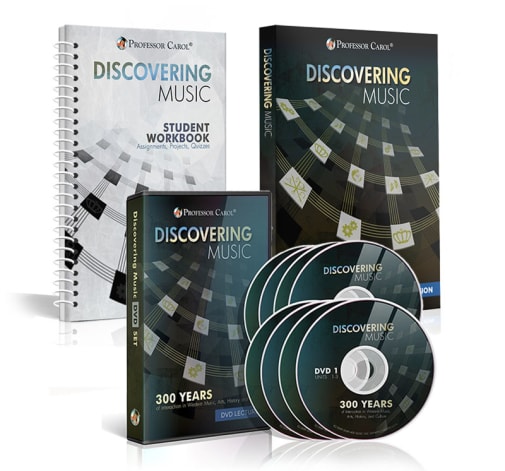Discovering Music Set (Text/WB/DVDs) 2nd EditionIn this revised and expanded 2nd edition, course components include a set of 8 DVDs, a spiral-bound workbook, a textbook, and access to online music and other resources. These are all included in the Discovering Music Set.
This course combines music history (learning about composers) with music appreciation (learning about their music) and shows how they interweave with as well as impact the intricate fabric of western culture. The scope of the course is breathtaking – a survey of 300 years (right before 1600 to the edge of WWI) of Western Music and the Arts. The author, Carol Reynold, is a well-loved professor of music history who supplies students with an abundance of primary and secondary sources and encourages her students to learn from them.
The textbook is 235 pages with lessons to read, vocabulary, lists of “Who's Who" and a glossary. There are 17 units covering:
- Using music history to unlock western culture
- Music entwined with great events in western history
- Technology, terminology, and cultural perspective
- Fanfare and power: the court of Louis XIV
- Sweeping away the Renaissance into the Baroque
- Liturgical calendar, street parties, and the new church music
- A lively journey through the life of Johann Sebastian Bach
- Enlightenment, classicism and the astonishing Mozart
- In the abyss: the century struggles with unfettered imagination
- Beethoven as hero and revolutionary
- Salons, poetry, and the power of the song
- A tale of four virtuosi and the birth of the tone poemNationalism and explosion of romantic opera
- The absolutely new world of Wagner
- Imperial Russia a cultural odyssey
- Load up the wagons: the story of American music
- Turning the page on western tradition with the explosion of war
The workbook is new and designed to serve as a companion to the Discovering Music Video Lectures and the Discovering Music text. In this new 2nd edition, the outline of 17 units covering the Common Practice Period from 1600 to 1914 has not changed a bit. Because the textbook was enlarged so much, they decided to extract the student material (exercises, viewing guides, projects), add and revise here and there, and give this material its own book. The new student workbook is spiral-bound with 222 pages, which should make it convenient to use.
The Teacher Manual is recommended if taking the course for credit. A teacher's manual is no longer available in print, but can be downloaded from the author's site for a small fee: www.professorcarol.com/professor-carols-store . Featured musical selections that are referenced in the course materials are available for listening online: www.professorcarol.com/dm-listening . Additional support materials are online: www.professorcarol.com/dm-supplement . ~Amber

